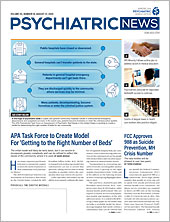Xywav Approved for Narcoleptic Daytime Sleepiness, Cataplexy
The FDA has approved Jazz Pharmaceuticals’ Xywav (calcium, magnesium, potassium, and sodium oxybates) oral solution for treating daytime sleepiness associated with narcolepsy in patients aged 7 years or older. The drug is also approved for treating cataplexy, a condition associated with narcolepsy in which a patient experiences sudden muscle weakness or paralysis that is triggered by strong emotions.
The FDA based its approval on the results of two phase 3 multicenter trials of patients with narcolepsy, one in 201 adult patients and one in 106 pediatric patients. Patients in the adult study received either 0.5 g/mL of Xywav or placebo for two weeks. Patients in the pediatric study received either placebo or up to 9 g/night of Xyrem, a previously approved medication with the same oxybate concentration as Xywav, for two weeks. In the adult study, patients who took placebo experienced a significant increase in the median weekly number of cataplexy episodes compared with those who took the active drug. They also had increases on the Epworth Sleepiness Scale (ESS). Patients receiving placebo in the pediatric study also experienced more severe cataplexy and narcolepsy. Side effects in adults included headache, nausea, dizziness, diarrhea, excessive sweating, anxiety, and vomiting.
Xywav has a boxed warning as a central nervous system depressant and for its potential for abuse and misuse, and it will be available only through a restricted program under a Risk Evaluation and Mitigation Strategy. Xywav will be a Schedule III medication, a designation that the Drug Enforcement Administration (DEA) gives drugs, substances, or chemicals that have a moderate to low potential for physical and psychological dependence.
Jazz Pharmaceuticals plans to launch the drug later this year.
Pimavanserin Being Considered for Psychosis Related to Dementia
The FDA is reviewing a supplemental New Drug Application for Nuplazid (pimavanserin) to treat hallucinations and delusions associated with dementia-related psychosis, Acadia Pharmaceuticals announced in July.
The company submitted the application after the phase 3 HARMONY trial suggested that pimavanserin may reduce the risk of psychosis relapse in patients with common subtypes of dementia including Alzheimer’s disease, dementia with Lewy bodies, Parkinson’s disease dementia, vascular dementia, and frontotemporal dementia spectrum disorders.
In the trial, 351 adults with dementia-related psychosis received 34 mg of pimavanserin once daily for 12 weeks. After that, they were randomized either to continue taking pimavanserin (20 mg or 34 mg daily) or to switch to placebo for up to 26 weeks or until their psychosis returned. Pimavanserin lowered the risk of psychosis relapse 2.8-fold compared with placebo. Those who took pimavanserin were also less likely to discontinue taking their pills.
BXCL501 May Reduce Agitation in Schizophrenia, Bipolar Disorder
BioXcel Therapeutics’s investigational BXCL501 (dexmedetomidine sublingual film) may reduce agitation in adult patients with schizophrenia or bipolar disorder, two phase 3 trials suggest.
Patients in both trials received either BXCL501 (120 mcg or 180 mcg) or placebo while they were experiencing agitation as measured via the Positive and Negative Syndrome Scale, Excitatory Component (PEC). SERENITY I included 381 patients with schizophrenia, and SERENITY II included 378 patients with bipolar disorder.
In both trials, patients who received BXCL501 had greater improvements in PEC scores at two hours compared with those who received placebo. Patients with schizophrenia who received the 180 mcg dose showed improvements in PEC scores as early as 20 minutes after treatment; similar rapid improvements were seen in patients with bipolar disorder who received either dose of the medication.
The most common side effects were mild to moderate sleepiness, dry mouth, and dizziness.
FDA Requires Discussion of Naloxone With Opioid Prescriptions
The U.S. Food and Drug Administration (FDA) in July announced that it is requiring updated labeling for opioid pain medications and medications used to treat opioid use disorder (OUD). The labeling for these products must now include a recommendation that health care professionals discuss the availability of naloxone with patients and caregivers when beginning and renewing treatment.
“Increased access to the opioid reversal medicine, naloxone, may help save lives by preventing opioid overdose deaths,” the agency stated in the Drug Safety Communication. “[These recommendations] will help ensure that health care professionals discuss the availability of naloxone and assess each patient’s need for a naloxone prescription when opioid pain relievers or medicines to treat OUD are being prescribed or renewed.”
The FDA also recommends that health professionals consider prescribing naloxone to patients at increased risk of opioid overdose, regardless of whether they are receiving a prescription for an opioid pain reliever or medicine to treat OUD. This includes patients who have a current or past diagnosis of OUD or who have had a previous opioid overdose. ■
